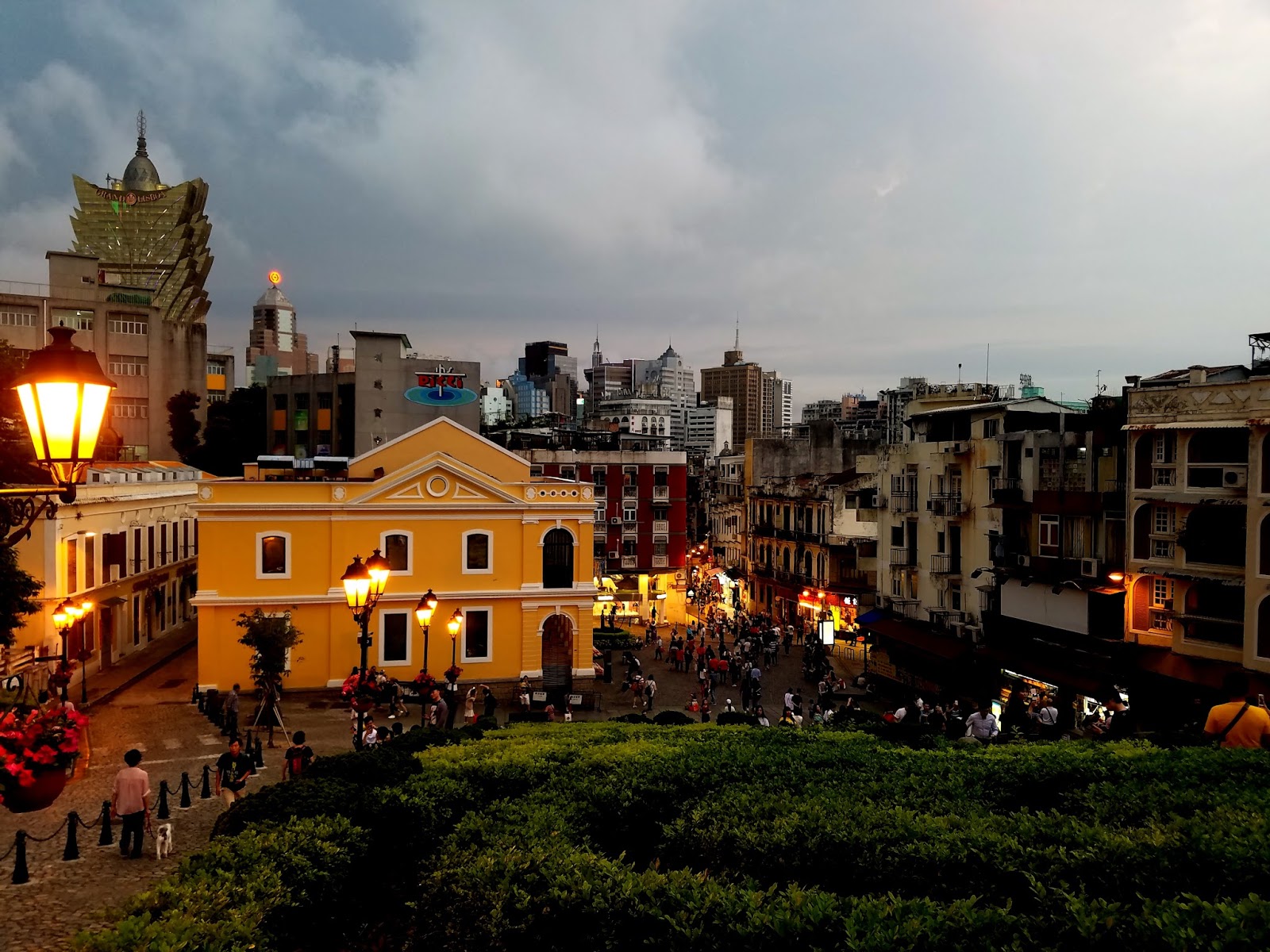Saint Paul's Ruin's in Macau

Macau reminded me very much of Hong Kong and Las Vegas at the same time. Where Hong Kong used to be governed by the British, Macau was governed by the Portuguese.
The primary language is Cantonese and Portuguese. Even the dialect sounds like some weird fusion of both Cantonese and Portuguese. You can see the influence of the Portuguese everywhere. The buses, the streets, the restaurants and the buildings. It's everywhere.
 |
| Many buildings and businesses had Macanese names that showed their Portuguese and Chinese roots |
How did the Portuguese get Macau you ask?
Around the year 1535, Portuguese merchants quickly settled and somehow took over as a Portuguese colony. The Ming Dynasty literally LEASED Macau to Portugal because it was a great port for trading. 200 years later Portuguese
In 1999 the Portuguese government gave back Macau to China. Yes, China is part of Macau just like Hong Kong is part of China too. Both Macau and Hong Kong are allowed to be independent like having their own money and judicial system and government.
However, its still under under China's One China principle.
"One Country, Two Systems."
Here's a little extra fun fact for you, Taiwan also falls under the One China principle.
TUN TUUUN TUUUUUN!
 |
| Yup. It's a sensitive subject for most Taiwanese though... |
Because it is.
And since its been liberated from Portugal, Macau has been trying heavily to build itself up and one of those ways is through major renovations.
And I mean MAJOR.
 | ||
Wynn Palace in Macau
|
 |
| Studio City Hotel in Macau. |
 |
| Galaxy Hotel in Macau |
 |
| Galaxy Hotel |
 Macau is regarded as a resort city, an up an coming Asian Las Vegas. While a lot of reconstruction is going on in the city trying to make new and more colossal Resorts here, there is another side of the city that is still intact from when the Portuguese were in power.
Macau is regarded as a resort city, an up an coming Asian Las Vegas. While a lot of reconstruction is going on in the city trying to make new and more colossal Resorts here, there is another side of the city that is still intact from when the Portuguese were in power. 
 I hopped on a M3 Bus just outside of the Airport and it took me on a nice a air-conditioned tour (Cheeeeeesus was it hot and humid that day) of the city. The bus stops were called out in Portuguese and Cantonese by the way so make sure if you get on a bus, you know your stop.
I hopped on a M3 Bus just outside of the Airport and it took me on a nice a air-conditioned tour (Cheeeeeesus was it hot and humid that day) of the city. The bus stops were called out in Portuguese and Cantonese by the way so make sure if you get on a bus, you know your stop. Around 16 stops later, I was


 |
| Following the street signs that lead to Saint Paul's Ruins |


There is a saying in Macau that says you, "If you don't visit Saint Paul's ruins, you haven't really been to Macau."
So when in

A few things I learned about ruins.
It's a popular tourist attraction (well, duh) and was first built in 1583 but rebuilt in 1602 due to a fire.
It cost around 2,500 pounds of silver in order to pay for the 2nd construction of the church. Which, back in the day, was A LOT!!!
No Cars can actually get there unless they're tiny delivery tuk tuks. So it can be a long inclined walk to get there.
They're literally ruins. The main face and stairs of the church are intact with a few restorations made for conservation.
The designer was a Italian Jesuit and the Japanese had a help in the construction. You can really see the West and East influence designs on the facade of the church. There are some Chinese words carved on the stone above some of the statues and even Japanese lions stand guard with its mouth open to let the rain water exit through it. There are also chrysanthemums bordering which are also a Japanese influence.
The reason only a facade of the church stands is because the rest of it was made of wood and burned down in a fire during the last turn of the 19th century.
The church faces south unlike most European churches who face the west.
Interesting right?
Let me know what you guys thing about this post!
As always,
Zai jian!
 |
| The inscription Mater Dei is Latin for Mother of God. |
 |
| This seven headed, winged hydra on the right top side of the church has a little woman standing on top of its head. That's the Holy Mother of God. The seven heads represent the seven deadly sins. |
 |
| The chinese characters next to the skeleton with an arrown through its chest says 念死者无为罪 which means "To say the Dead are not Guilty." Loosely translated, death can happen at anytime so always atone and stay away from sins? |
 |
| I.H.S. stands for Iesus Hominum Salvator is Latin for Jesus, Savior of Men. A Jesuit sign marked on the entrance face of the Church. |
 |
| The Holy Mother statue in the center just below the tier of Jesus's statue. |
 |
| Interesting little shines I kept seeing popping up on random streets. These are Chinese deities are worshiped here by local people. |
 |
| The end of the day view of my last day in Macau |





















wanna PEACE
ReplyDeleteof Me??
-Jesus